Part XII rolls on through the summer of 1991 into the early autumn, highlighting as it does the rest of August and the entire month of September. Since I've now concluded with the first three quarters of 1991, I might take a small break for a few other blog ideas in the upcoming weeks, but I'll be back very soon for the final three Mega Archive entries for this year. Expect to see things heat up between the Mega Drive and SNES as we move into the busy holiday period, especially once Sega introduces their divisive CD peripheral.
There's a heavy Japanese influence on this edition of the Mega Archive: all but three of the following games were developed in Sega's neck of the woods, and around half this list never even saw an international release or localization. That isn't to say our old occidental friends EA and Tengen didn't have something on the docket for September '91, just that they were a little quieter than they've been in previous months. We'll also encounter a few new curious developers this time, including a pioneer of 3D polygonal graphics, an eventual ubiquitous middleware purveyor, and another company from my home nation (one that primarily dealt in licensed shovelware, but still. Represent).
Here's the usual list of previous episodes, for those just joining us:
- Part I: 001-020 can be found here.
- Part II: 021-035 can be found here.
- Part III: 036-050 can be found here.
- Part IV: 051-065 can be found here.
- Part V: 066-080 can be found here.
- Part VI: 081-098 can be found here.
- Part VII: 099-115 can be found here.
- Part VIII: 116-130 can be found here.
- Part IX: 131-145 can be found here.
- Part X: 146-160 can be found here.
- Part XI: 161-175 can be found here.
Part XII: 176-190 (August '91 - September '91)
176: Jewel Master
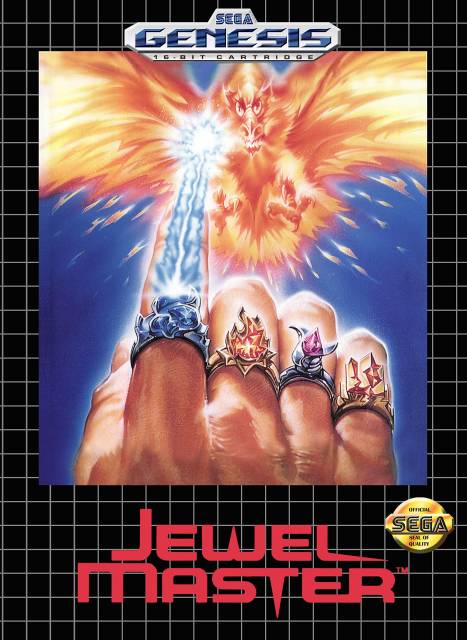
- Developer: Sega
- Publisher: Sega
- JP Release: 1991-08-30
- NA Release: 1991
- EU Release: November 1991
- Franchise: N/A
- Genre: Action / Platformer
- Theme: Fantasy
- Premise: The Jewel Master is a hero capable of equipping multiple magical rings and combining their effects, like a fantasy Liberace. Just have to kill one little demon tyrant and get back before the evening's Las Vegas performance.
- Availability: Original cart only. While it is a first-party game, I don't think it was enough of a hit to put it in consideration for a slot in Sega Genesis Classics or the upcoming Sega Genesis Mini.
- Preservation: Jewel Master has a neat idea of combining weapons to produce new attack patterns, one that Treasure would later put to greater effect for Gunstar Heroes, but the game itself is a little drab and unimpressive. A fantasy-themed combination platformer/brawler/shooter like Elemental Master (what's with all the "masters"?), the ring-switching mechanic had to do a lot of the heavy lifting as you tinker in the pause menu figuring out which combinations created the best outcomes - since there's also a few necessary abilities linked to the ring configuration, like double-jump and speed up, you spend a lot of time in here. It's worth noting that FromSoftware would also give this whole ring combining business a shot in their first-person dungeon crawler Eternal Ring, so even if the game itself wasn't a household name its influence still got around. Jewel Master's other major noteworthy quality is the solid soundtrack by legendary Sega composer Motoaki Takenouchi who, for whatever reason, named most of the game's BGM after Yes songs (the tracks themselves, meanwhile, definitely have a Castlevania flair to them).
177: Sports Talk Baseball / Pro Yakyuu Super League '91
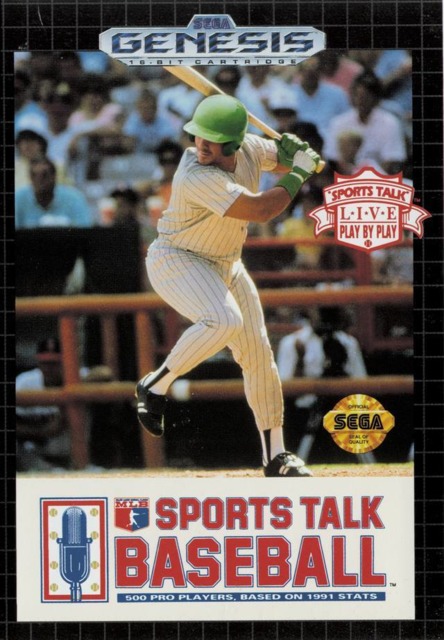
- Developer: Sega
- Publisher: Sega
- JP Release: 1991-08-30 (as Pro Yakyuu Super League '91)
- NA Release: May 1992 (as Sports Talk Baseball)
- EU Release: N/A
- Franchise: Super League
- Genre: Baseball
- Theme: Pro Sports
- Premise: You know what's better than sucking at sports games? Having the game itself call you out on it with its play-by-play commentary of your crapitude. Welcome to Sports Talk Baseball.
- Availability: I'm guessing for licensing reasons, Sega hasn't rereleased this anywhere. Plenty of modern sports games have a commentary mode, I'm guessing.
- Preservation: It feels we're going out of order here a little, as Sports Talk Baseball is in some ways a spiritual successor to Joe Montana II: Sports Talk Football where all this play-by-play commentary tech debuted, but it turned out Sega simply retooled an older Pro Yakyuu game of theirs for international audiences with the new tech installed. Well regarded for its time, Sports Talk Baseball was actually the second baseball game Sega ever put out after Tommy Lasorda Baseball, released way back close to the system's launch. I guess they were looking for an edge before they put out their next first-party slugfest: live (if robotic and slow) commentary, game saves for the pennant race mode, and the MLBPA license allowing real player names must've been a salivating combo for fans of America's Pastime back then.
178: Back to the Future Part III
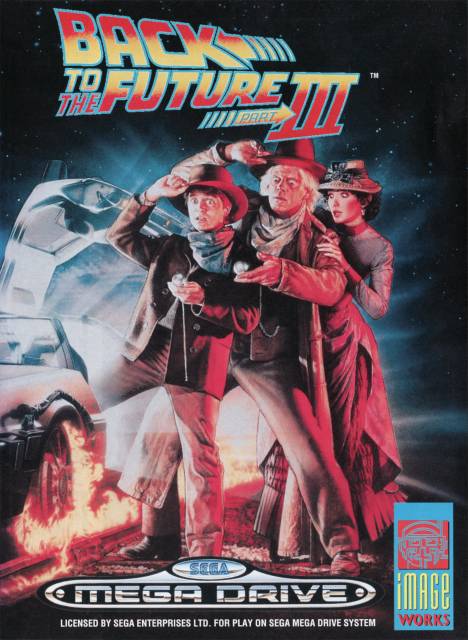
- Developer: Probe Entertainment
- Publisher: Arena Entertainment (NA) / Image Works (EU)
- JP Release: N/A
- NA Release: 1991-Q3
- EU Release: February 1992
- Franchise: Back to the Future
- Genre: Action / Shooter
- Theme: Sci-fi / Western
- Premise: That Marty McFly kid needs to get back to the future again, but wouldn't you know it? The DeLorean's out of juice and Doc's fated to get shot by Biff Tannen's distant relative "Mad Dog" Buford.
- Availability: Licensing problems aside, I can't see why anyone would want to rerelease this.
- Preservation: Anyone who rented BTTF Part 3 back in the day (or worse, bought it or received it as a gift) probably only knows about the first level - the one where Doc Brown on horseback has to rescue Clara Clayton from her runaway stagecoach. This stage is so pointlessly difficult, where enemies and projectiles fly into view microseconds before they smack you in the face, that most players gave up here and never saw the rest of the game. I recall playing the Atari ST demo a lot: it thankfully shifted the gameplay to the second level, the one that recreates the scene where Marty shows off his Wild Gunman skills on a carnival game, that was actually kind of fun in a generic shooting gallery sort of way. It was hard to narrow a date down for this one: best guess based on the games press at the time would be somewhere in the autumn of 1991, about a year after the movie came out. Let me tell you from experience, it did not feel like a game that required a whole year to develop.
179: F-22 Interceptor: Advanced Tactical Fighter
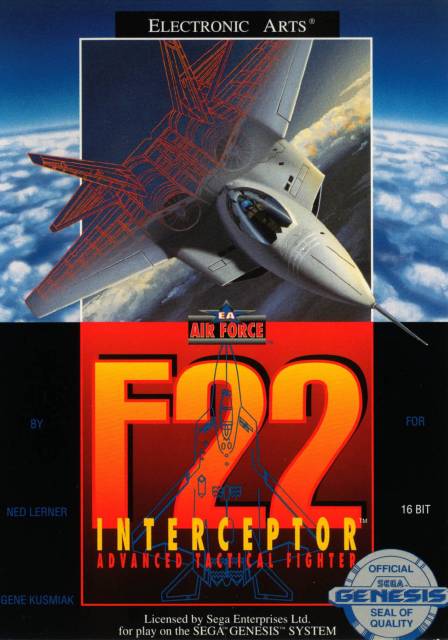
- Developer: Lerner Research / Electronic Arts
- Publisher: Electronic Arts
- JP Release: 1993-02-12
- NA Release: September 1991
- EU Release: 1991-11-21
- Franchise: EA Air Force
- Genre: Flight Sim
- Theme: Modern Military
- Premise: Take to the skies in the F-22 Raptor (a jet fighter that had yet to be flown in the military proper) in missions across the US, North Korea, Iraq, and Soviet Russia.
- Availability: Relatively inaccessible, but then older flight sims aren't usually in high demand. It doesn't even have HOTAS support.
- Preservation: At first glance, F-22 Interceptor struck me as the sort of serious computer combat flight sim that EA impulsively attempted to port to a home console, but the truth is that the game was built specifically for the Sega Genesis: it's exclusive to the system, in fact. The history, or rather the future, of F-22 is what fascinated me most when reading up about it. The director, Ned Lerner, was a pioneer of 3D flight sim tech and would later take that expertise (and his company, Lerner Research) into Blue Sky Productions - the prototypical Looking Glass Studios, later famous for System Shock, Thief, and Ultima Underworld. These three game franchises utilized a lot of his 3D knowhow and all became trailblazers in one way or another. It's also remarkable that while the Genesis suffered trying to render the game's polygonal graphics with its limited hardware, the game offered multiple camera angles: something standard in most sims and driving games today, but relatively unheard of in 1991. Like with little UK studio Argonaut and their collaboration with Nintendo on Star Fox, being a developer with some working knowledge of 3D in the early 90s was evidently more valuable than gold.
180: Pac-Mania
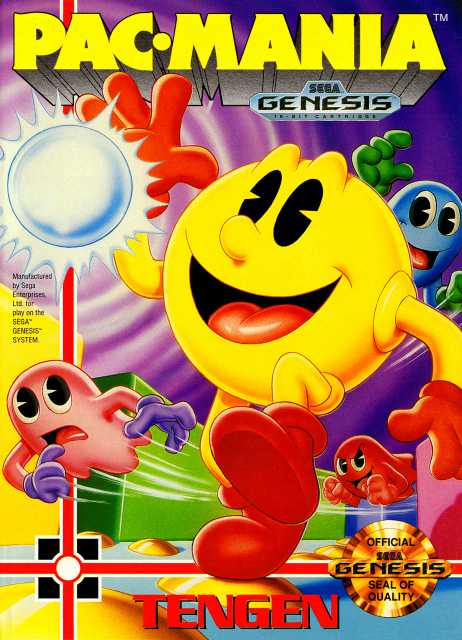
- Developer: Sculptured Software
- Publisher: Tengen
- JP Release: N/A
- NA Release: September 1991
- EU Release: 1991
- Franchise: Pac-Man
- Genre: Maze Action
- Theme: Horror (Ghosts)
- Premise: The perspective has changed, but Pac-Man and his voracious appetite for dots sure hasn't. Unless you include the fact that he can jump now.
- Availability: Namco loves rereleasing Pac-Man in all his forms, so there are dozens of places to find Pac-Mania. More recent compilation appearances include Namco Museum Megamix for Wii, Pac-Man Collection for GBA (and Wii U Virtual Console), and Pac-Man Museum for Steam, PS3, and Xbox 360.
- Preservation: I'm not sure what Tengen's relationship with Namco was, but the Japanese arcade giant didn't seem to mind all the half-assed ports Tengen was making of some of their most famous games. Pac-Mania was the Tetris 2 of that franchise: well-liked but certainly not to the same extent as the original, which was already perfect and probably didn't need to be tweaked this much. For one, Pac-Mania's fancy new isometric look meant you can only see a small segment of the full board at any moment, making tracking down those final dots more of a hassle. For whatever reason Tengen and Sculptured Software made this port as drab as possible; Blocktown's multicolored riff on Lego has been rendered in nothing but blues and greys here.
181: Road Rash
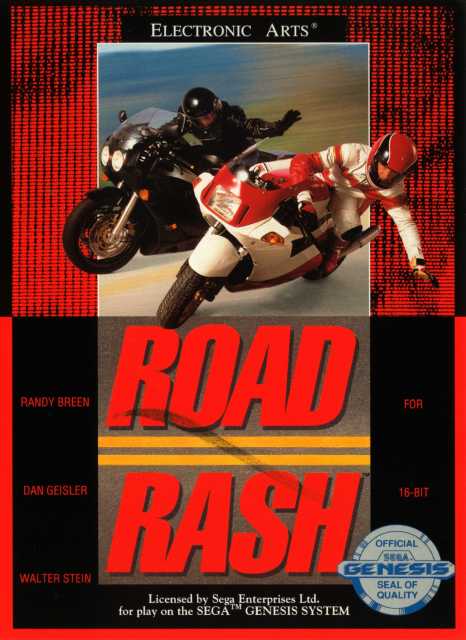
- Developer: Electronic Arts
- Publisher: Electronic Arts
- JP Release: 1991-11-20
- NA Release: September 1991
- EU Release: September 1991
- Franchise: Road Rash
- Genre: Motorcycle Driving / Vehicular Combat
- Theme: Violence
- Premise: It's much easier to win an intrastate race if all the other competitors are roadkill. Don't forget to bring a helmet; nobody's too punk for proper road safety.
- Availability: There's an EA Replay compilation for PSP featuring the game. If the Road Rash series isn't on Origin yet, it probably should be. Failing all that, there's always Road Redemption, the recent Indie "spiritual successor".
- Preservation: I shouldn't need to introduce what Road Rash is, though I will say I was ignorant of its origins as a Genesis game. It makes more sense in retrospect, of course; it perfectly fits with the tough guy image Sega of America was trying to project to make their rivals seem like the kind of wusses who would never hit another biker with a baseball bat in the middle of a race. Some online sources seem to think that the September 1991 debut of the game was only for Europe, and that the States had to wait until the Japan release the following year, which uh... EA is an American company, so why would they delay it that long? Methinks someone accidentally copy/pasted the wrong data somewhere, as I can't find anything to corroborate this delay at all (and there are US game mag captures promoting the game's September '91 release to boot). This is why it's always important to check multiple sources, with physical media follow-ups if available.
182: Galaxy Force II
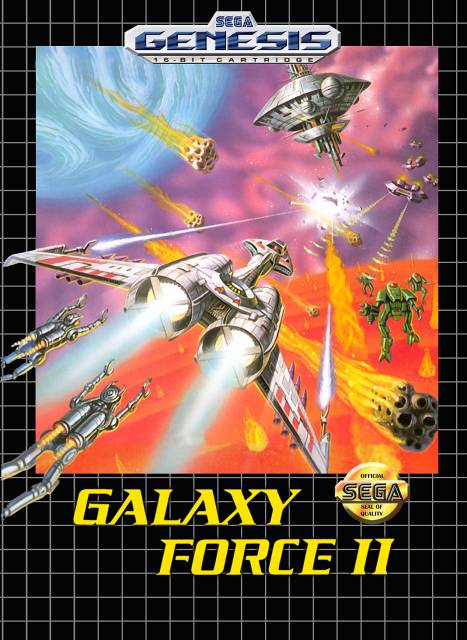
- Developer: Sega / CRI
- Publisher: Sega
- JP Release: 1991-09-13
- NA Release: February 1992
- EU Release: 1992
- Franchise: Galaxy Force
- Genre: Shoot 'em Up
- Theme: Sci-fi
- Premise: There's always an evil Space Empire. The cosmos is crawling with them. Doesn't mean you shouldn't blow them all to kingdom come.
- Availability: It's popped up in a few Sega compilations, albeit older ones, and it was also on the Wii Virtual Console and presently on Steam. These days, though, the best version readily available would be its 3DS remaster 3D Galaxy Force II. It's like those pixel asteroids are really whizzing by your face!
- Preservation: Lots to discuss here. The first is that like a few Sega arcade games, the "II" in the title isn't so much referring to a full sequel than a modified remake released shortly after the original that fixed everything that was broken. This was back when you had to have different distributions instead of a quick and easy patch system to address any issues in the launch 1.0 version. Second is that it took a few years for this one to hit the Mega Drive, and by then it had already been passed around home computers in both the east (FM Towns) and west (Amiga, Atari ST). Third is that this port (and its other ports) include a credit for CRI: at the time a companion division of Sega's set up by their corporate overlords SCSK, the major IT company that bought them in 1984. In addition to supplying most of the hardware R&D for Saturn, CRI would have a close relationship with Sega's AM2 division, eventually folding into it by 2000, and then the entire division became CRI Middleware: a now fairly ubiquitous middleware provider that caters to many major AAA studios. You've probably seen their blue-and-white CRIWare logo a hundred times.
183: El Viento
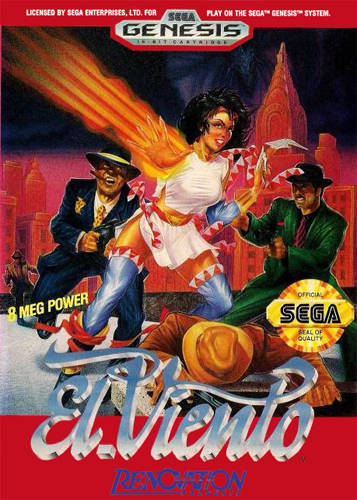
- Developer: Wolf Team
- Publisher: Wolf Team (JP) / Renovation (NA)
- JP Release: 1991-09-20
- NA Release: November 1991
- EU Release: N/A
- Franchise: Earnest Evans
- Genre: Action / Brawler
- Theme: Horror
- Premise: Annet Futatabi might belong to the bloodline of the ancient evil deity Hastur, but that doesn't mean she intends to let its zealots destroy the world.
- Availability: Original cart only. Wolf Team is presently subsumed in the Bandai Namco anime gestalt, so I'm not sure if or when they'll ever rerelease their older games.
- Preservation: Wolf Team made a lot of odd games for Sega, but none more so than the Earnest Evans trilogy, of which El Viento is the second part (despite being released first; I told you it was a weird series). Compared to the twirly arms of Evans, El Viento's protagonist Annet (the eponymous heroine of the third game also) is relatively straightforward with her boomerangs and fast speed, but there's a whole lot of momentum to get used to as you rapidly pace through each level. It's like a much quicker Valis, or perhaps a Ninja Gaiden. The story's sensible at least: you spend most of the time killing 1930s gangsters to stop the cultists they've allied with from bringing in a Cthulhu-esque monster from another dimension. It's a shame there aren't more Lovecraftian anime, but then that's how you get Urotsukidoji: Legend of the Overfiend and, well, big yikes to that.
184: Rent A Hero
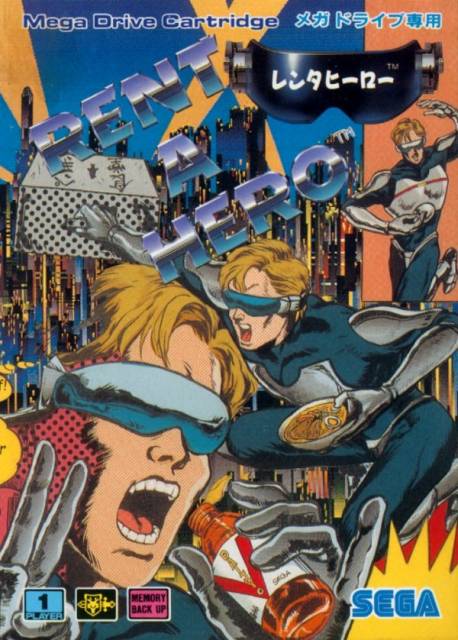
- Developer: Sega
- Publisher: Sega
- JP Release: 1991-09-20
- NA Release: N/A
- EU Release: N/A
- Franchise: Rent A Hero
- Genre: Brawler / Action-Adventure
- Theme: Superhero
- Premise: Taro Yamada meant to order from the pizza place but instead got sent the high-tech armor that allows him to be Rent A Hero: part-time crimefighter for hire.
- Availability: Not very available - Rent A Hero was Japanese Mega Drive only. It has a Dreamcast remake, but that was Japan-only too.
- Preservation: One of those lost Sega classics that sometimes comes up with conversations with hardcore Sega fans - it shows up in a number of other Sega games as a cameo, most notably as one of the unlockable fighters in Fighters Megamix - Rent A Hero is this RPGish/fighter hybrid where you're following a story and walking around talking to people, but fights are these one-on-one brawls with Street Fighter style gestures for moves. Despite indications that it was considered for worldwide release - the hero looks very Caucasian, for one - the game is so densely packed with deprecating in-jokes about Japanese culture, tokusatsu and sentai shows, and Sega itself, that any localization team probably balked at the task. It doesn't help that the game is very heavy on dialogue and exposition, as you go around acquiring tasks to do as the titular crusader on the job, which is why it took so long for a fan translation to emerge. It's a fascinating if flawed game that sees Sega taking their earliest steps towards a story-driven, open-world Japanese life sim with occasional brawls - an idea they'd build on for their later Shenmue and Yakuza franchises.
185: Master of Weapon
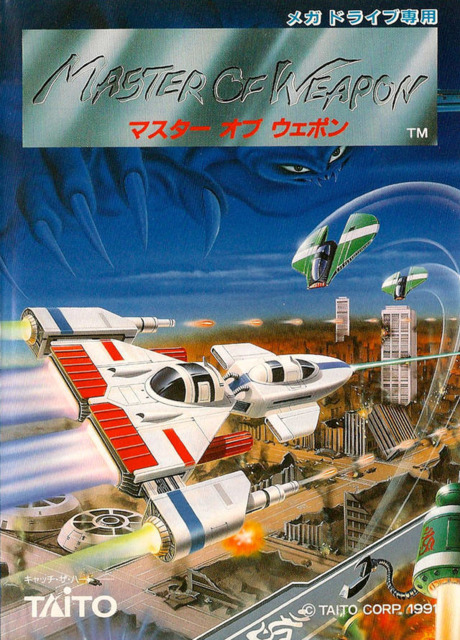
- Developer: KID Corp
- Publisher: Taito
- JP Release: 1991-09-27
- NA Release: N/A
- EU Release: N/A
- Franchise: N/A
- Genre: Shoot 'em Up
- Theme: Sci-fi
- Premise: A synthetic human and his experimental jet fighter is mankind's best chance against the rogue AI created to fix the environment. He is... the Master of Weapon. Just the one weapon, though. Give him a knife and he'd have no idea what to do with it.
- Availability: Japan-only.
- Preservation: Another day, another arcade Taito shoot 'em up conversion for Mega Drive. Master of Weapon runs into a familiar problem where its arcade cabinet was set-up specifically for its vertical nature but the Mega Drive port has to deal with the default 4:3 landscape mode, which greatly reduces visibility for what's approaching - it doesn't help that the player's ship sprite is fairly big, making it even harder to avoid incoming foes. It's also a half-hearted Xevious clone with a few power-ups and visual tricks, but old hat by 1989 (its arcade release) and certainly by 1991 (the Mega Drive port). Taito are definitely making their presence known on the system by porting every shmup in their library, and on this occasion hiring KID Corp for conversion duties: a company primarily known at the time for their B-tier NES and Game Boy games. We'll see them once more on the Mega Archive very soon and then never again.
186: Mercs / Senjou no Ookami II
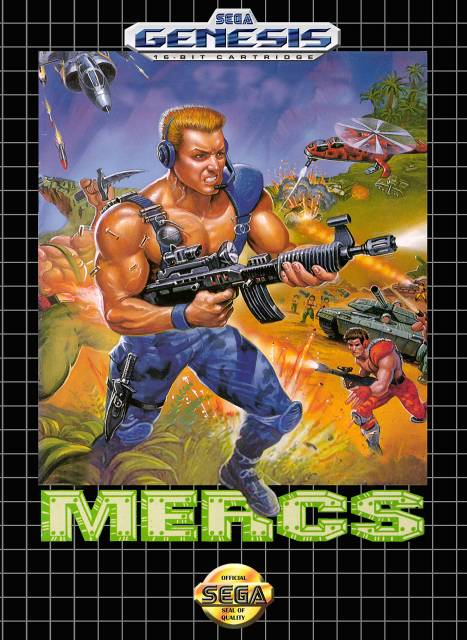
- Developer: Sega
- Publisher: Sega
- JP Release: 1991-09-27 (as Senjou no Ookami II)
- NA Release: October 1991 (as Mercs)
- EU Release: December 1991 (as Mercs)
- Franchise: Commando
- Genre: Shooter
- Theme: Modern Military
- Premise: Super Joe's back with his MERCS team, and the enemy forces won't know what hit them. Unless they played Commando, in which case they should know what to expect. Do your homework guys, jeez.
- Availability: There's the Mega Drive game and the Wii Virtual Console port of same, and the arcade version shows up in a few Capcom compilations like Capcom Generations Vol. 4 (PS1 and Saturn) and Capcom Classics Collection Vol. 1 (PS2 and Xbox).
- Preservation: Sega took the reins from Capcom for this port of the lesser-known sequel to Commando, adapting the game to include an almost completely different "Original Mode" with features that made more sense for a home console game, like a weapon shop between levels where you could buy upgrades and replenish health. Controls smoothly and definitely retains that Commando run and gun spirit as you charge ahead through gunfire; the only problem is the lack of multiplayer (it's weird that Sega dropped the ball there, since a lot of why they made Streets of Rage was to capitalize on the fumble of the SNES Final Fight port being single-player only - another Capcom port, no less). You'd be hard pressed to find many arcade ports with a whole separate bespoke game mode inside it though.
187: Uchuu Senkan Gomorrah
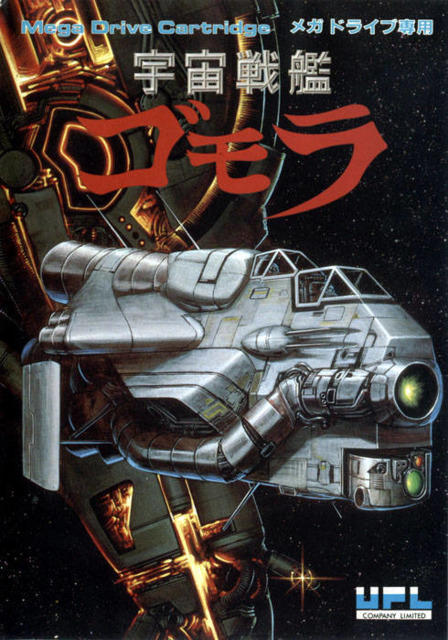
- Developer: Aisystem Tokyo
- Publisher: UPL
- JP Release: 1991-09-30
- NA Release: N/A
- EU Release: N/A
- Franchise: N/A
- Genre: Shoot 'em Up
- Theme: Sci-fi
- Premise: Why would you call your massive interplanetary battleship Gomorrah if you didn't want it smote by an angry all-powerful force? And what happened to Space Battleship Sodom? ...Problems with the exhaust, you say?
- Availability: The Mega Drive port was Japan only, but the original arcade cabinet did come over to the States at some point. It's called Bio-Ship Paladin there, though the ship itself doesn't look all that organic.
- Preservation: NMK/UPL went for something a little non-traditional here, switching out the usual speedy starfighters of this genre for an enormous lumbering warship. Maneuverability's down, but the clunker is packed with firepower, including a secondary weapon that can be aimed anywhere on the screen. The gameplay accounts for these differences also, giving you slower bullets to dodge but way more enemies on the screen to clear out before you can navigate safely through. Not perhaps the most ingenious ideas - I think most shmup players put more stock in movement than firepower on the whole - but at least it's something a bit different. Kinda need that when the Mega Drive has two or three of these types of games coming out a month.
188: Pyramid Magic III
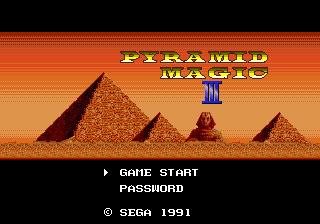
- Developer: Sega
- Publisher: Sega
- JP Release: 1991
- NA Release: N/A
- EU Release: N/A
- Franchise: Pyramid Magic
- Genre: Puzzle
- Theme: Egyptian
- Premise: We're still trying to get to the center of this darn magical pyramid. It's starting to feel like this whole escapade wasn't worth the trouble. Explorerman hasn't seen his children in months.
- Availability: Originally sold via Sega MegaNet, an online service and precursor to the Sega Channel. There's a physical compilation of the Pyramid Magic games, but it's Japanese Mega CD only.
- Preservation: We're going to finish off this week's update with a trio of 1991 Game Toshokan releases, starting with the third and final Pyramid Magic. Unlike the first sequel, Pyramid Magic III bothered to include a brand new mechanic which - naturally - makes the game's usual business of carrying and smashing blocks to reach the exit even more difficult, because now you have to carry a block - actually a vase full of water - to the exit before it'll open. This vase will shatter if you even look at it askew, so it's an extra layer of hassle on top of all the other precise maneuvers you need to follow to reach the end of each level. There weren't any more Pyramid Magic games after this, so it's possible the explorer protagonist managed to find his treasure. Given the game's charming disposition though, I figure he probably gets eaten alive by scarab beetles like that one dude from The Mummy.
189: Aworg: Hero in the Sky
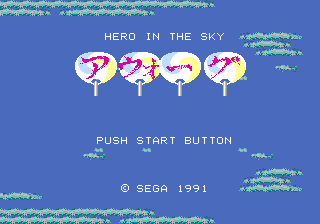
- Developer: Sega
- Publisher: Sega
- JP Release: 1991
- NA Release: N/A
- EU Release: N/A
- Franchise: N/A
- Genre: Action
- Theme: Fans
- Premise: It is a bird? Is it a plane? No, it's Aworg, some dumbass flapping his arms real hard.
- Availability: Sega MegaNet only. You'd need a Japanese Mega Drive, a Sega Modem, an online subsciption, and a time machine back to the early '90s. Or buy a Sega Mega Drive Mini from Japan (see below).
- Preservation: I didn't realize until working on the Game Toshokan entries this week that the Game no Kanzume Otokuyou compilation, which features a selection of Game Toshokan games including Aworg and Medal City (next one down), will be one of the featured games on the Japanese (and mainland Asia) Mega Drive Mini. That means a lot of them will see an indirect release this year, which means I guess these aren't quite the forgotten B-games I assumed they were. Aworg's one of the more interesting titles to come out of this service for a while, as it's one of those momentum-based action games like Lunar Lander where you have to be careful with after-touches and thrust so you don't careen into hazards. You have separate dedicated buttons for A) using the fans to project yourself skyward and B) using them to create gusts to move obstacles out of your way, provided they aren't bolted to the ground. It follows Pyramid Magic's basic format of needing a series of keys to exit each stage, but it features a layer of complexity to its traversal that these generic Game Toshokan games have been missing.
190: Medal City
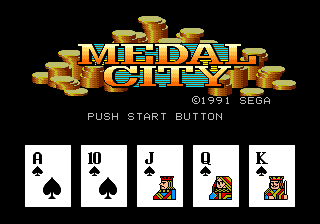
- Developer: Sega
- Publisher: Sega
- JP Release: 1991
- NA Release: N/A
- EU Release: N/A
- Franchise: N/A
- Genre: Gambling
- Theme: Gambling
- Premise: Win big in Medal City, where the only currency is medals. I mean, card sharp skills and a stony poker face. No wait, I was right the first time.
- Availability: Sega MegaNet only. Just go to a real casino instead. They sometimes have a free shrimp buffet there.
- Preservation: Well, yeah, see above. This game will see an unexpected new lease of life when it appears on the Sega Mega Drive Mini in the near future via its inclusion in the Game no Kanzume Otokuyou compilation. Unlike Aworg and Pyramid Magic, which were real games, I'd posit that Medal City doesn't deserve it: it's just three gambling activities - poker, blackjack, and slots, so they're really going obscure there - that you can play for fake money ad nauseam. There is a target goal, but it's so ridiculously high that you'll be playing these games for hours to reach it: there's even a password system so you can pick up wherever you left off. I'm not convinced these games make you a better gambler and there's no rewards to earn, unlike in RPGs where gambling is a quick way to earn some valuable items or the necessary capital to equip a high-level party, so I don't really get it. But then, like Jack Burton, I was not put on this Earth to "get it".
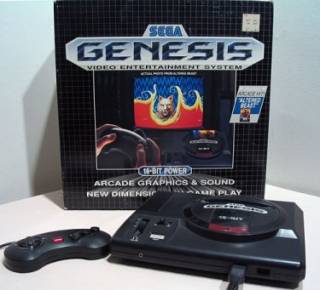
Log in to comment